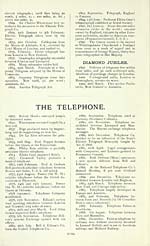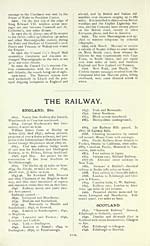Scotland > 1862, 1868, 1872, 1882-1885, 1893-1896, 1901-1904 - County directory of Scotland > 1901-1904
(29)
Download files
Complete book:
Individual page:
Thumbnail gallery: Grid view | List view

1890-92. Telephones almost universally
adopted.
1891. 14th March. Submarine Anglo-
Franco telephone cable submerged. First
communication from London to Paris sent
by Prince of Wales (now King Edward
VII.) to President Carnot.
1891. 1st April. The same opened to
the public.
1891. 19th April. Telephone between
London, Marseilles and Brussels.
1892. 5th April. Telephone between
Dublin and Belfast.
1892. June. Act passed for Government
to purchase the trunk lines of the Telephone
Union.
1892, October. Telephone from New
York to Chicago (950 miles).
1896, 4th April. The State acquires
the trunk line of the telephone connecting
London with nearly every centre of the
United Kingdom through the National
Telephone Co., which still controls its
local exchange areas. 247 trunk telephone
wires ; 30,000 miles of wire plus 20,000
constructed by the Post Office.
1896, 4th April. Transfer of telephone
trunk lines, completed 6th February
1S97.
.1897, October. 10,000 words recorded
by typewriter from telephone in five hours
100 miles distant.
WIRELESS TELEGRAPHY.
The electrical influence of ether waves,
a wireless force across country, through
water or hills, from a flying train and be-
tween ships at sea 186,000 miles in a second,
or seven times round the world. Attained
speed of messages so transmitted 15 words
per minute, radiating outwards in every
direction, the electricity of the ether being
energised and diffused through the infinity
of space.
The great experimentalists and dis-
coverers have been Franklin, Watson,
Nikola Tesla, Winckler (1746), Professor
Morse, Dr Oliver Lodge, Sir Wm. H.
Preece, Joseph Henry (1838), Professor
Trowbridge, Maxwell, Elisha Gray,
Chicago (1877), Hertz (1888), Edison and
Marconi, Sir Wm. N. Cooke and Sir
Chas. Wheatstone (1837), Steinheil (1837),
Highton, Brett, Lettle, Gintt (Vienna),
Stearn (Boston), Sir Francis Ronalds,
Lesarge (1744), Betancourt (1787),
Cavello (1795), Salve (1796), Sremmaner-
ing (1809). In particular : —
In 1834 James Bowman Lindsay accom-
plished wireless telegraphy through water,
patented it in 1854, and further experi-
mented Ijetween London and Portsmouth.
In 1859 he laid it before the British Asso-
ciation at Aberdeen.
1842. Electric waves discovered by
Joseph Henry.
In 1842 Professor Morse, at Washington,
sent a message 80 feet, and in 1844 effected
the completion of the electric circuit through
water.
In 1845 Joseph Henry enlarged the
knowledge of the subject.
In 1864 Maxwell discovered unknown
rays or waves.
In 1888 Hertz determined the (Hertzian)
waves (X rays).
In 1893 Sir W^m. Preece reported ihe
distance of electrical vibrations to the
British Association at Montreal, and an-
nounced the transmission of messages across
the Bristol Channel (35 miles).
1894. Sir Wm. Preece reports to the
Society of Arts that speech had been trans-
mitted by telephone across Loch Ness.
JAMES B. LINDSAY.
1896, iilh December. Sir Wm. Preece,
as the Engineer-in-Chief of the Post Office,
announces that Mr Marconi had come to
him with bis wireless system, depending
on electric waves with a vibration of 250,000
a second (^^6' biographical note, page XV.).
In August 1898 the Prince of Wales
(now King Edward VII.), on board the
Osborne yacht, sent a message to the
Duke of Edinburgh at Osborne House (8
miles).
1898. Signals reporting vessels in dis-
tress sent shorewards from lightships 12
miles distant.
On I7lh March 1S99 the first wireless
adopted.
1891. 14th March. Submarine Anglo-
Franco telephone cable submerged. First
communication from London to Paris sent
by Prince of Wales (now King Edward
VII.) to President Carnot.
1891. 1st April. The same opened to
the public.
1891. 19th April. Telephone between
London, Marseilles and Brussels.
1892. 5th April. Telephone between
Dublin and Belfast.
1892. June. Act passed for Government
to purchase the trunk lines of the Telephone
Union.
1892, October. Telephone from New
York to Chicago (950 miles).
1896, 4th April. The State acquires
the trunk line of the telephone connecting
London with nearly every centre of the
United Kingdom through the National
Telephone Co., which still controls its
local exchange areas. 247 trunk telephone
wires ; 30,000 miles of wire plus 20,000
constructed by the Post Office.
1896, 4th April. Transfer of telephone
trunk lines, completed 6th February
1S97.
.1897, October. 10,000 words recorded
by typewriter from telephone in five hours
100 miles distant.
WIRELESS TELEGRAPHY.
The electrical influence of ether waves,
a wireless force across country, through
water or hills, from a flying train and be-
tween ships at sea 186,000 miles in a second,
or seven times round the world. Attained
speed of messages so transmitted 15 words
per minute, radiating outwards in every
direction, the electricity of the ether being
energised and diffused through the infinity
of space.
The great experimentalists and dis-
coverers have been Franklin, Watson,
Nikola Tesla, Winckler (1746), Professor
Morse, Dr Oliver Lodge, Sir Wm. H.
Preece, Joseph Henry (1838), Professor
Trowbridge, Maxwell, Elisha Gray,
Chicago (1877), Hertz (1888), Edison and
Marconi, Sir Wm. N. Cooke and Sir
Chas. Wheatstone (1837), Steinheil (1837),
Highton, Brett, Lettle, Gintt (Vienna),
Stearn (Boston), Sir Francis Ronalds,
Lesarge (1744), Betancourt (1787),
Cavello (1795), Salve (1796), Sremmaner-
ing (1809). In particular : —
In 1834 James Bowman Lindsay accom-
plished wireless telegraphy through water,
patented it in 1854, and further experi-
mented Ijetween London and Portsmouth.
In 1859 he laid it before the British Asso-
ciation at Aberdeen.
1842. Electric waves discovered by
Joseph Henry.
In 1842 Professor Morse, at Washington,
sent a message 80 feet, and in 1844 effected
the completion of the electric circuit through
water.
In 1845 Joseph Henry enlarged the
knowledge of the subject.
In 1864 Maxwell discovered unknown
rays or waves.
In 1888 Hertz determined the (Hertzian)
waves (X rays).
In 1893 Sir W^m. Preece reported ihe
distance of electrical vibrations to the
British Association at Montreal, and an-
nounced the transmission of messages across
the Bristol Channel (35 miles).
1894. Sir Wm. Preece reports to the
Society of Arts that speech had been trans-
mitted by telephone across Loch Ness.
JAMES B. LINDSAY.
1896, iilh December. Sir Wm. Preece,
as the Engineer-in-Chief of the Post Office,
announces that Mr Marconi had come to
him with bis wireless system, depending
on electric waves with a vibration of 250,000
a second (^^6' biographical note, page XV.).
In August 1898 the Prince of Wales
(now King Edward VII.), on board the
Osborne yacht, sent a message to the
Duke of Edinburgh at Osborne House (8
miles).
1898. Signals reporting vessels in dis-
tress sent shorewards from lightships 12
miles distant.
On I7lh March 1S99 the first wireless
Set display mode to: Large image | Transcription
Images and transcriptions on this page, including medium image downloads, may be used under the Creative Commons Attribution 4.0 International Licence unless otherwise stated. ![]()
| Scottish Post Office Directories > Scotland > County directory of Scotland > 1901-1904 > (29) |
|---|
| Permanent URL | https://digital.nls.uk/85502923 |
|---|
| Description | County directory of Scotland(For 1901-1904) |
|---|---|
| Attribution and copyright: |
|
| Description | Irregular. Published 1862-[1912?] |
|---|---|
| Shelfmark | Map.Ref.C18 |
| Additional NLS resources: | |
| Description | Directories of the whole, or large parts of, Scotland. |
|---|
| Description | Around 700 Scottish directories published annually by the Post Office or private publishers between 1773 and 1911. Most of Scotland covered, with a focus on Edinburgh, Glasgow, Dundee and Aberdeen. Most volumes include a general directory (A-Z by surname), street directory (A-Z by street) and trade directory (A-Z by trade). |
|---|


